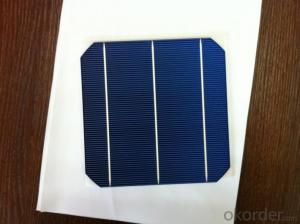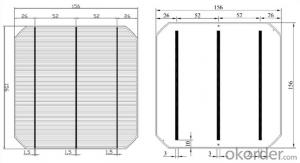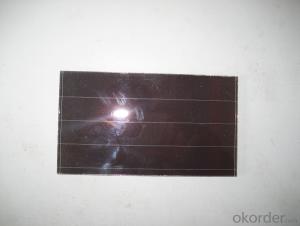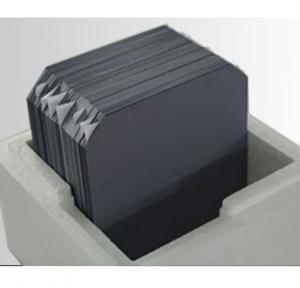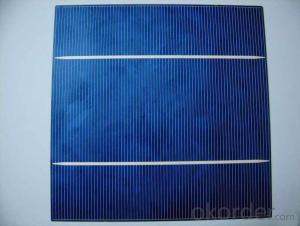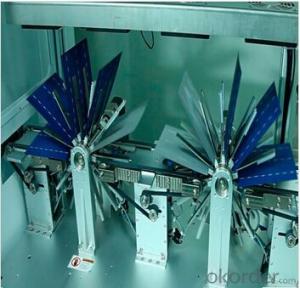Mono Solar Cells156mm*156mm in Bulk Quantity Low Price Stock
- Loading Port:
- Shanghai
- Payment Terms:
- TT OR LC
- Min Order Qty:
- 10000 pc
- Supply Capability:
- 100000 pc/month
OKorder Service Pledge
OKorder Financial Service
You Might Also Like
Item specifice
Brief Introduction
- Up to 20.0% efficiency, one of the highest performing mono crystalline cells on the market
- Three bus bars boosts current collection over the entire cell area, leading to higher fill factors
- Blue anti-reflecting coating allows more sunlight be captured and converted to electricity
- Finer, closer fingers improves charge collections for improved energy yield
- Lower light-induced degradation leads to greater power output over the entire module lifetime
- All solar cells are tightly classified to optimize output of module
- Maximum yield and longevity due to hotspot prevention
- Premium appearance results in a highly uniform and aesthetically appealing module
Specification
- Product Mono-crystalline silicon solar cell
- Dimension 156 mm x 156 mm ± 0.5 mm
- Thickness 200 μm ± 30 μm
- Front 1.5 ± 0.1 mm busbar (silver)
- Silicon nitride antireflection coating
- Back 3.0 mm continuous soldering pads (silver)
- Back surface field (aluminum)
Electric performance parameters

- Testing conditions: 1000 W/m2, AM 1.5, 25 °C, Tolerance: Efficiency ± 0.2% abs., Pmpp ±1.5% rel.
- Imin : at 0.5 V
Light Intensity Dependence
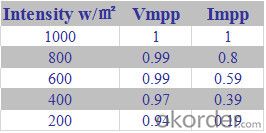
Soldering Ability
- Peel Strength: > 1.0 N/mm (Pull soldered ribbon from busbar in 5 mm/s of 180°)
Dimension Figure

Quick Response
- Any time and anywhere, reply clients' email and solve all problems happen in the work at the first time.
- Remove clients doubts and offer the best solution at the first time.
- Give our clients the lastest news of the photovoltaic, update the newest stock informtion.
Production and Quality Control
- Precision cell efficiency sorting procedures
- Stringent criteria for color uniformity and appearance
- Reverse current and shunt resistance screening
- ISO9001,ISO14001 and OHSAS 18001,TUV Certificated


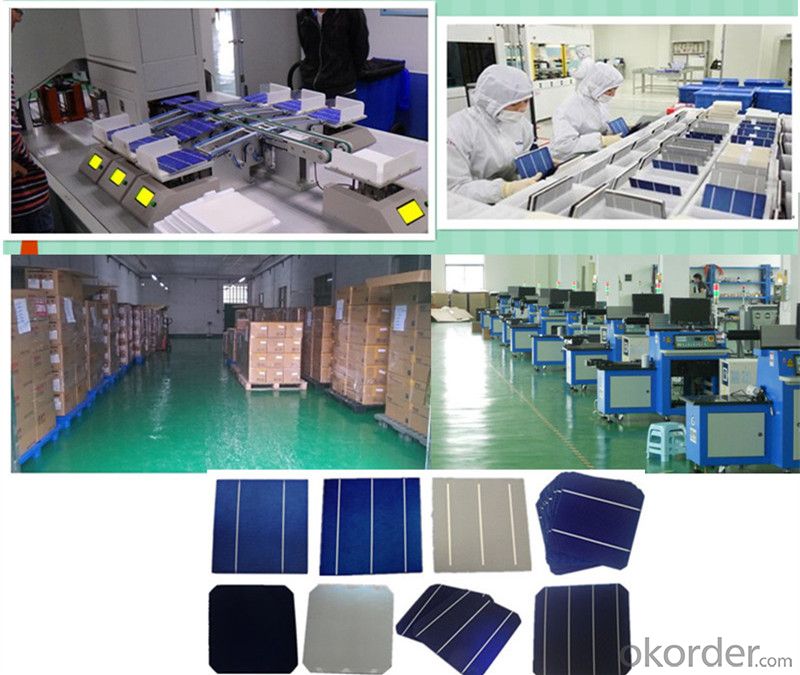
FAQ:
1. Q: Do you have your own factory?
A: Yes, we have. Our factory located in Jiangsu
2. Q: How can I visit your factory?
A: Before you visit,please contact us.We will show you the route or arrange a car to pick you up.
3. Q: Do you provide free sample?
A: Commenly we provide paid sample.
4. Q: Could you print our company LOGO on the nameplate and package?
A: Yes, we accept it.And need an Authorization Letter from you.
5. Q: Do you accept custom design on size?
A: Yes, if the size is reasonable.
6. Q: How can I be your agent in my country?
A: Please leave feedback. It's better for us to talk about details by email.
7. Q: Do you have solar project engineer who can guide me to install system?
A: Yes, we have a professional engineer team. They can teach you how to install a solar system.
- Q:What is the role of gettering in solar silicon wafers?
- Gettering in solar silicon wafers plays a critical role in improving the overall efficiency and performance of solar cells. It involves the intentional introduction of impurities or defects in the wafers to capture and immobilize harmful impurities, such as metallic contaminants or dislocations. By effectively gettering these impurities, gettering enhances the purity and quality of the silicon material, reducing recombination and improving the electrical properties of the solar cells. This process helps to increase the conversion efficiency of solar panels, allowing them to generate more electricity from sunlight.
- Q:How do defects affect the efficiency of a solar silicon wafer?
- Defects in a solar silicon wafer can significantly impact its efficiency. These defects can include impurities, grain boundaries, or crystal lattice imperfections. They can hinder the movement of charge carriers, reducing the overall electrical conductivity of the wafer. This results in a decreased conversion of sunlight into electricity, lowering the efficiency of the solar cell. Additionally, defects can trap or recombine charge carriers, leading to a loss of generated electrical current. Therefore, minimizing defects is crucial in maximizing the efficiency of a solar silicon wafer.
- Q:What are the current trends in solar silicon wafer technology?
- Some of the current trends in solar silicon wafer technology include the shift towards thinner wafers, such as the adoption of 180-200 micrometer thickness, which reduces material costs and improves efficiency. Another trend is the development of larger wafer sizes, with the industry moving from 156 mm to 182 mm and even 210 mm sizes, enabling higher power output and reducing installation costs. Additionally, there is a focus on improving the overall quality and uniformity of wafers to optimize solar cell performance.
- Q:The best process can be attached to explain!
- The silicon wafer contact material uses the quartz material, does not contact the metal material
- Q:What is the expected lifetime of a solar silicon wafer?
- The expected lifetime of a solar silicon wafer is typically around 25 to 30 years.
- Q:How does the thickness of a passivation layer affect the efficiency of a solar silicon wafer?
- The thickness of a passivation layer on a solar silicon wafer directly affects its efficiency. A thicker passivation layer can reduce surface recombination of charge carriers, improving the overall efficiency of the solar cell. It helps to minimize the loss of electrons and holes at the surface, leading to better charge extraction and increased power output. However, an excessively thick passivation layer can also hinder light absorption, limiting the generation of charge carriers and subsequently reducing the efficiency. Therefore, finding an optimal passivation layer thickness is crucial for maximizing the efficiency of a solar silicon wafer.
- Q:The microprocessor integrates the computer with what is on a small silicon chip
- The microprocessor integrates the arithmetic and controller into a small piece of silicon.
- Q:What is the role of solar silicon wafers in promoting energy independence at the community level?
- Solar silicon wafers play a crucial role in promoting energy independence at the community level. These wafers are the key component in solar panels, which convert sunlight into electricity. By harnessing solar power, communities can reduce their reliance on traditional fossil fuel sources, contributing to a greener and more sustainable energy future. Solar silicon wafers enable the generation of clean and renewable energy, reducing carbon emissions and dependence on external energy providers. This helps communities become self-sufficient in meeting their energy needs, leading to greater energy independence and resilience.
- Q:Below what the photovoltaic industry specific industry classification, solar silicon manufacturing enterprises, mainly engaged in single and polycrystalline silicon, polycrystalline silicon wafer cutting casting, single enterprise, what are the concrete classification, a solar silicon slice of this industry?
- Polysilicon for chemical, silicon wafer for machining, battery components for semiconductor processing
- Q:How do solar silicon wafers contribute to the overall cost of a solar panel?
- Solar silicon wafers are a significant contributor to the overall cost of a solar panel. The manufacturing process involved in producing high-quality wafers requires advanced technology and precision, making it a costly step. Additionally, the demand for silicon wafers has increased with the growing solar industry, leading to a rise in their prices. As a result, the cost of solar silicon wafers directly impacts the final price of solar panels.
1. Manufacturer Overview |
|
|---|---|
| Location | |
| Year Established | |
| Annual Output Value | |
| Main Markets | |
| Company Certifications | |
2. Manufacturer Certificates |
|
|---|---|
| a) Certification Name | |
| Range | |
| Reference | |
| Validity Period | |
3. Manufacturer Capability |
|
|---|---|
| a)Trade Capacity | |
| Nearest Port | |
| Export Percentage | |
| No.of Employees in Trade Department | |
| Language Spoken: | |
| b)Factory Information | |
| Factory Size: | |
| No. of Production Lines | |
| Contract Manufacturing | |
| Product Price Range | |
Send your message to us
Mono Solar Cells156mm*156mm in Bulk Quantity Low Price Stock
- Loading Port:
- Shanghai
- Payment Terms:
- TT OR LC
- Min Order Qty:
- 10000 pc
- Supply Capability:
- 100000 pc/month
OKorder Service Pledge
OKorder Financial Service
Similar products
New products
Hot products
Hot Searches
Related keywords

